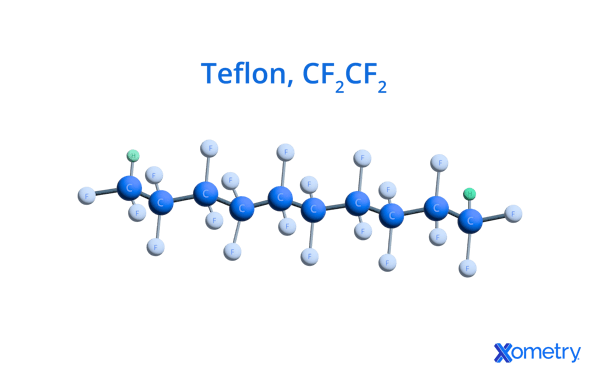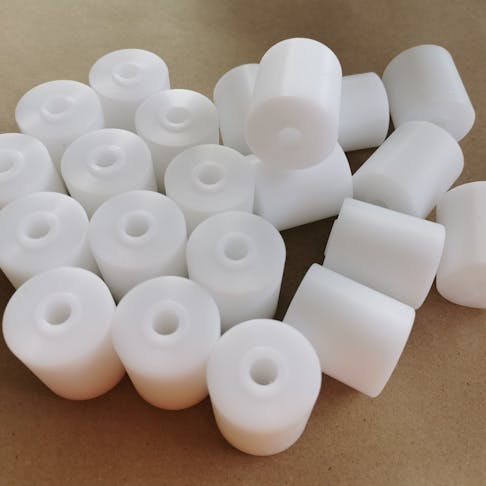Your most slippery cookware, heated hair tools, and the wire coatings around your home all have a material in common: Teflon. This sleek coating pops up in both household and industrial settings and, because of its lack of friction and thermal and chemical resistance, it gets coated onto quite a lot of products.
What is Teflon?
Polytetrafluoroethylene (PTFE) is a fluoropolymer coating that’s usually referred to by its trademark name Teflon—which is much less of a tongue twister. It has a combination of fluorine and carbon atoms that give it unique thermal, mechanical, and chemical advantages.
An employee for DuPont named Roy J. Plunket accidentally created Teflon while trying to invent a different type of refrigerant and, after discovering all of its useful characteristics, it became a popular choice for coating.
Composition and How it’s Made
Polytetrafluorethylene’s chemical makeup involves fluorine atoms surrounding carbon atoms in a protective layer. You can see in the image below how these atoms link together and form a molecular structure.

To create PTFE, you’ll need fluorspar, hydrofluoric acid, chloroform, and water. Then they’ll chemically react in a special heated chamber. Once this happens, tetrafluoroethylene is synthesized from the process, which then goes on to get polymerized, leading to the creation of PTFE.
Properties and Characteristics
Teflon is a go-to choice because of its low friction and high temperature and chemical resistance. We’ve put tables down below that explain the different physical, mechanical, and electrical properties of Teflon.
Physical Properties
Here are a handful of some of Teflon’s physical properties worth noting:
| Physical Properties | Values |
|---|---|
Physical Properties Density [g/cm3] | Values 2.07 |
Physical Properties Hardness [Shore D] | Values 57 |
Physical Properties Friction Coefficient [Steel] | Values 0.0646 |
Physical Properties Water Absorption [%] | Values 0.0074 |
Physical Properties Melting Temperature [°C] | Values 325 |
Table Credit: https://matweb.com/
| Mechanical Properties | Values |
|---|---|
Mechanical Properties Ultimate Tensile Strength [MPa] | Values 35 |
Mechanical Properties Yield Strength [MPa] | Values 20.5 |
Mechanical Properties Elongation at Break [%] | Values 306 |
Mechanical Properties Flexural Yield Strength [MPa] | Values 19.6 |
Mechanical Properties Flexural Modulus [GPa] | Values 0.672 |
Mechanical Properties Compressive Yield Strength [MPa] | Values 10.2 |
Mechanical Properties Charpy Impact Strength [J/cm2] | Values 1.76 |
Table Credit: https://matweb.com/
| Electrical Properties | Values |
|---|---|
Electrical Properties Electrical Resistivity [Ω.cm] | Values 8.68E+17 |
Electrical Properties Surface Resistance [Ω] | Values 4.48E+17 |
Electrical Properties Dielectric Constant | Values 2.39 |
Electrical Properties Dielectric Strength [kV/mm] | Values 58.7 |
Electrical Properties Dielectric Loss Index | Values 0.0001 |
Electrical Properties Arc Resistance [sec] | Values 346 |
Table Credit: https://matweb.com/
Chemical and Optical Properties
Teflon offers some impressive chemical properties that give it an upper hand in certain situations and make it such a good coating for different types of products. It’s resistant to acids, bases, solvents, hydrocarbons, oils, fuels, water, and alcohol—making it one of the most chemically resistant choices out there. That being said, it doesn’t do so well when it’s up against alkali metals, gaseous fluorine, chlorine trifluoride, and oxygen difluoride.
As far as optical properties go, there is a version of Teflon (Teflon AF) that can have a high level of optical clarity and great UV stability, which is helpful for some applications and manufacturing needs.
Types of Teflon
There are a few variations of PTFE out there, and here are six of the most common to know about:
1. Granular PTFE
This Teflon is a powder and it usually bolsters rods or tubes, which will be made through compression molding and then sintered. It is created through suspension polymerization.
2. Fine Powder PTFE
Also a powder and sometimes called emulsion-grade PTFE, this version of Teflon is finer in texture and made with the help of emulsion polymerization. The paste-like form of it gets extruded into wires, tubes, films, and fibers.
3. Micro Powder PTFE
Made of even finer particles, Teflon of this kind comes to be through direct polymerization. It can go through milling and grinding, as well, and it helps lessen friction on the surfaces that will be subject to wear and tear and flames.
4. Dispersion PTFE
This style of Teflon has its particles dispersed in a fluid, which makes it a great choice for coatings that you’ll need to apply on things like fabric or cookware. The liquid format makes it easy to cling onto surfaces and provide the qualities people want from Teflon.
5. Film PTFE
This is a PTFE found in film or tape form made by shaving down a thick, solid bar of PTFE. It’s a good choice for helping stick different materials together.
6. Expanded PTFE
Made up of tiny fibers, this Teflon type usually is used for gaskets, mostly due to its top-notch thermal and chemical resistance.

Applications
Teflon can be found in so many products and components, so we’ve listed out a few examples:
- Bearings and seals
- Electrets
- Chemically inert liners for storage tanks and pipes
- Tensioned membrane structures
- Composites
- Musical instrument coatings, like for guitar strings and wind instruments
- Lubricants between surfaces
- Kitchenware as coatings for pots and pans
- Medical products like tubes, catheters, and pumps
- Coatings for automotive gaskets, wires, seals, and bushings
- Coatings on spacecraft and rovers
- Insulators for electric wires
Advantages vs Disadvantages
There are a few benefits you’ll find in working with Teflon, including the following
- Good thermal resistance: Teflon can handle temperatures of up to 325 ℃ and extremely cold temperatures as low as 275 ℃.
- Low friction: Teflon can take the prize for having the lowest friction out of almost any other material out there.
- Chemically inert: While it can’t handle some chemicals, for the most part, Teflon is highly resistant and inert to a wide range.
There are also a handful of characteristics that can make it limiting or difficult to work with Teflon:
- Nonstick: Although this is a perk for things like cookware, it’s not ideal when you need to bond Teflon to another surface.
- High thermal expansion: When compared to other plastics, you’ll find Teflon expands more than most.
- Poor radiation resistance: Although it’s chemically resistant, radiation is one such thing that’ll break down Teflon.
- Not biodegradable: Unfortunately, Teflon isn’t a biodegradable material, but it is recyclable.
How Xometry Can Help
We offer services that work with Teflon, including Teflon CNC machining. We also have plenty of other manufacturing and processing options that involve plastics and polymers, like plastic 3D printing, plastic extrusion, and nylon CNC machining.
Copyright and Trademark Notices
- Teflon® is a trademark of the Chemours Company
- Rulon® is a trademark of the Dixon Industries Corporation
Disclaimer
The content appearing on this webpage is for informational purposes only. Xometry makes no representation or warranty of any kind, be it expressed or implied, as to the accuracy, completeness, or validity of the information. Any performance parameters, geometric tolerances, specific design features, quality and types of materials, or processes should not be inferred to represent what will be delivered by third-party suppliers or manufacturers through Xometry’s network. Buyers seeking quotes for parts are responsible for defining the specific requirements for those parts. Please refer to our terms and conditions for more information.


